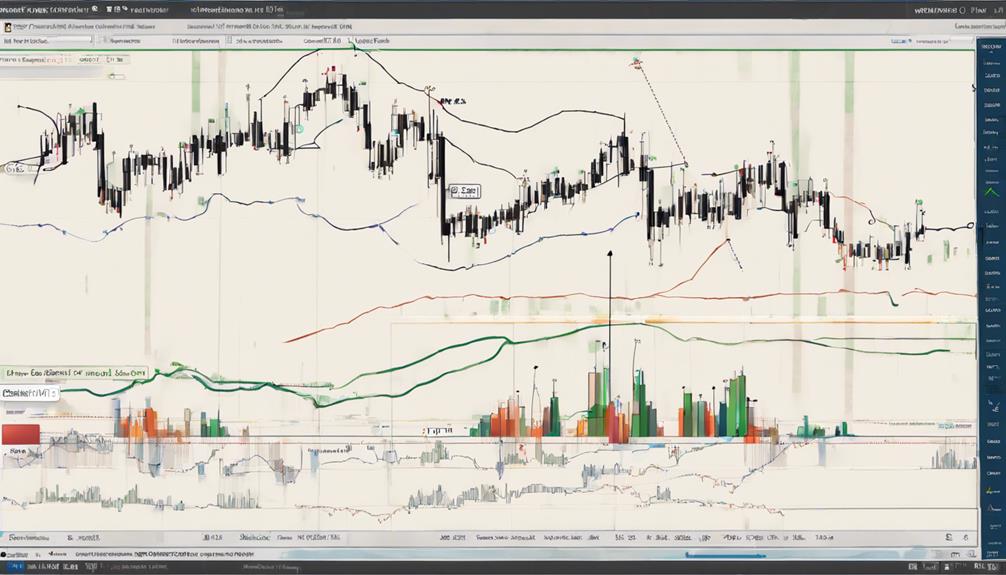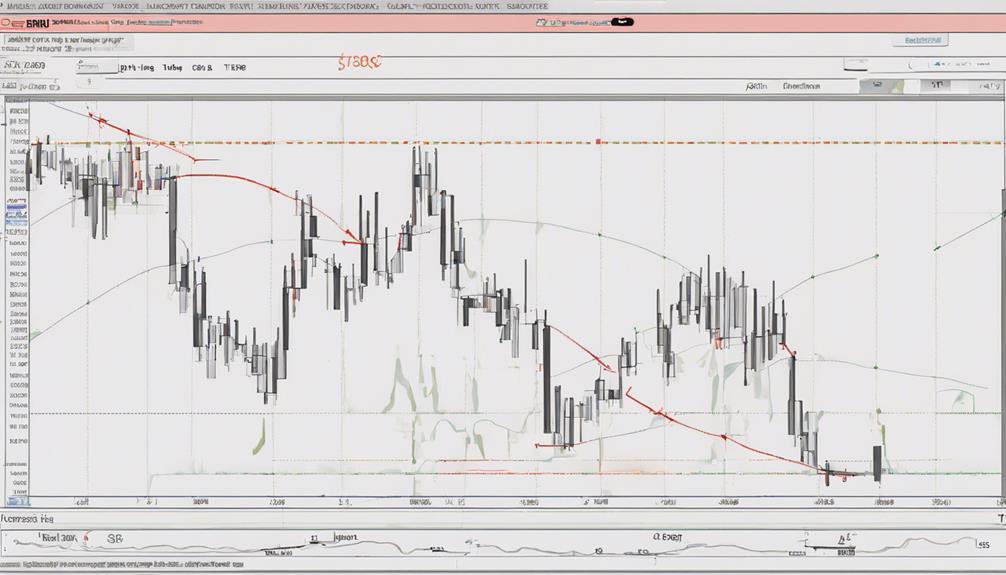In the realm of binary options trading, mastering the art of utilizing Parabolic SAR effectively can significantly enhance your trading outcomes.
The seven essential tips outlined for leveraging this indicator encompass crucial aspects such as customization, risk management, and strategic implementation.
By honing your understanding of these key principles, you can navigate the complexities of the market with greater precision and confidence.
But what exactly are these tips, and how can they elevate your trading prowess in the world of binary options?
Understanding Parabolic SAR Basics
In grasping the fundamental principles of binary options trading, a pivotal concept to comprehend is the basic functionality of the Parabolic SAR indicator. The Parabolic SAR indicator, which stands for Stop and Reverse, is a technical analysis tool that provides traders with potential entry and exit points in the market. It plots dots above or below price bars to indicate the direction of the trend. Dots above the price bars suggest a downtrend, while dots below signal an uptrend. These dots act as trailing stops on positions, helping traders manage their risk effectively.
Understanding how the Parabolic SAR indicator generates trade signals based on the interaction of its dots with price bars is crucial for making informed trading decisions. By analyzing the placement of the dots in relation to price movements, traders can identify potential trend reversals or continuations, guiding them on when to enter or exit trades. Mastering the basics of the Parabolic SAR indicator is essential for traders looking to enhance their binary options trading strategies.
Setting Proper Parameters

Optimal parameter selection plays a critical role in maximizing the effectiveness of the Parabolic SAR indicator. Understanding the sensitivity of SAR to different parameter values is essential for fine-tuning its performance.
Testing various parameter combinations can help traders identify the most suitable settings for their specific trading strategies.
Optimal Parameter Selection
Setting the appropriate parameters for Parabolic SAR, particularly the Step and Maximum Step values, is essential for optimizing its effectiveness in binary options trading. The Step value determines how fast the SAR dots converge towards the price, impacting the indicator's sensitivity to price movements.
On the other hand, the Maximum Step parameter regulates the acceleration factor, controlling the speed at which the dots can reverse positions. Proper parameter selection aligns the Parabolic SAR with the trader's specific trading strategy, enabling accurate trend capture and informed decision-making.
Adapting these parameters to current market conditions is vital for enhancing the indicator's performance and ensuring its relevance in the dynamic landscape of binary options trading.
Understanding SAR Sensitivity
Adjusting the Step and Maximum Step parameters of the Parabolic SAR indicator is pivotal in fine-tuning its sensitivity to price movements for optimal trading outcomes. When it comes to trading and SAR sensitivity, consider the following:
- Short-term Traders: Lowering the Step value increases sensitivity, allowing for quicker reactions to price changes, which can be beneficial for short-term trading strategies.
- Long-term Traders: Increasing the Step value reduces sensitivity, making the indicator less reactive to short-term fluctuations, thus suiting traders with longer-term positions.
- Enhanced Signal Accuracy: Proper parameter settings not only impact sensitivity but also play a significant role in enhancing the accuracy of Parabolic SAR signals, aiding traders in making informed decisions based on reliable data.
Testing Different Parameter Values
To effectively fine-tune the sensitivity of the Parabolic SAR indicator in binary options trading, exploring various parameter values through systematic testing is essential for optimizing trading strategies. Adjusting the Step and Maximum Step parameters can significantly impact the SAR indicator's responsiveness to price movements.
Lower Step values increase sensitivity, making the indicator react more quickly to short-term changes in the market. On the other hand, higher Maximum Step values reduce sensitivity, offering smoother signals that are better suited for identifying longer-term trends.
Identifying Entry and Exit Points

Analyzing SAR signal confirmation can provide valuable insights into market trends and potential entry or exit points.
Timing entry accurately based on the shift of Parabolic SAR dots can enhance trading precision and reduce risk exposure.
Setting clear exit strategies aligned with price movements relative to Parabolic SAR dots is crucial for maximizing profitability and managing trading positions effectively.
SAR Signal Confirmation
Effectively identifying entry and exit points in binary options trading relies heavily on the confirmation of SAR signals through the strategic observation of Parabolic SAR dots switching positions relative to price bars. Traders can enhance their decision-making process by understanding how to interpret these signals accurately.
Here are three key aspects to consider when confirming SAR signals:
- Switching Positions: Wait for the Parabolic SAR dots to switch from above to below the price bars in an uptrend to identify potential entry points.
- Exit Points: Recognize exit opportunities when the SAR dots transition from below to above the price bars in a downtrend.
- Avoiding False Signals: Confirming SAR signals helps traders avoid false indicators, leading to more precise trade entries and exits.
Timing Entry Accurately
When considering the timing of entry accurately in binary options trading, a meticulous observation of Parabolic SAR shifts above or below price bars is crucial for strategic decision-making.
The Parabolic SAR indicator provides valuable signals for identifying potential entry points based on the direction of its movement in relation to price action. Traders often look to enter a trade when the SAR shifts below the price bars, indicating a potential uptrend, or conversely, when it shifts above the price bars, signaling a possible downtrend.
Setting Exit Strategies
To enhance the precision of trading decisions in binary options, establishing effective exit strategies by identifying entry and exit points based on Parabolic SAR indicators is essential for risk management and profit maximization.
When setting exit strategies using the Parabolic SAR Strategy, consider the following:
- Utilize Parabolic SAR Dots as Trailing Stops: Use the Parabolic SAR dots as trailing stops to signal potential exit points as the trend progresses.
- Exit Long Trades in Downtrends: Exit long trades when the price drops below the Parabolic SAR dots in a downtrend to secure profits and minimize losses.
- Initiate Short Trades in Uptrends: In uptrends, consider initiating short trades when the price moves above the Parabolic SAR dots to capture potential downward movements efficiently.
Implementing Risk Management Strategies

Implementing robust risk management strategies is essential for navigating the volatility of binary options trading with Parabolic SAR. Utilizing stop-loss orders is a fundamental aspect of risk management in this context, as they help limit potential losses by automatically closing a trade at a predetermined price level. Additionally, it is prudent to define a maximum percentage of your trading account that you are willing to risk on each trade. This approach ensures that no single trade has the capacity to significantly impact your overall account balance. Employing position sizing techniques further complements risk management efforts by preventing a single unfavorable trade from wiping out your entire trading capital.
Diversification is another key component of effective risk management in binary options trading. By spreading your capital across multiple trades rather than concentrating it all in one, you can reduce the impact of any single trade gone wrong. Regularly reviewing and adjusting your risk management strategies based on your trading performance and prevailing market conditions is crucial for long-term success in binary options trading with Parabolic SAR.
Using Parabolic SAR in Trending Markets

Effective utilization of Parabolic SAR in trending markets is paramount for binary options traders seeking to capitalize on clear trend identification and optimal entry and exit points. In such market conditions, the alignment of Parabolic SAR dots with the price direction provides valuable insights for traders.
Here are three key points to consider when using Parabolic SAR in trending markets:
- Trend Identification: Parabolic SAR dots below price bars indicate an uptrend, signaling the strength of the upward movement and potential buying opportunities. Conversely, dots above price bars suggest a downtrend, highlighting the momentum of the downward movement and potential selling chances.
- Reliable Entry and Exit Points: The Parabolic SAR strategy is most effective in trending markets, offering traders reliable entry and exit points based on the alignment of the dots with price movements.
- Maximizing Effectiveness: Traders should prioritize using Parabolic SAR in trending markets to maximize its effectiveness in binary options trading, helping them make informed decisions and enhance their trading performance.
Avoiding Common Mistakes

Frequently overlooked aspects in binary options trading involve the common mistakes associated with the misinterpretation of Parabolic SAR indicators and inadequate risk management practices.
One prevalent error is ignoring the trend direction indicated by Parabolic SAR dots, leading to incorrect trade entries. Additionally, traders often fail to use supplementary indicators to validate Parabolic SAR signals, increasing the risk of false signals and subsequent losses.
Overtrading based solely on Parabolic SAR signals is another common pitfall, resulting in excessive losses due to impulsive trading. Furthermore, disregarding market conditions and volatility when utilizing Parabolic SAR can lead to poor trade decisions, as these factors significantly impact the effectiveness of the strategy.
Lastly, neglecting proper risk management principles while trading with the Parabolic SAR strategy poses a substantial risk of capital loss. To mitigate these common mistakes, traders should focus on interpreting Parabolic SAR signals accurately, using additional indicators for confirmation, and implementing robust risk management strategies to safeguard their investments.
Backtesting Your Strategy

In evaluating the efficacy of a binary options trading strategy utilizing the Parabolic SAR indicator, conducting thorough backtesting on historical data is a crucial initial step. Backtesting involves testing the strategy on past data to assess its performance.
Here are three key reasons why backtesting is essential when using the Parabolic SAR indicator:
- Performance Evaluation: Backtesting helps traders understand how the strategy would have fared in the past market conditions. It provides insights into the strategy's profitability and risk management capabilities based on historical data.
- Strategy Refinement: By backtesting a trading strategy with the Parabolic SAR indicator, traders can identify strengths and weaknesses. This analysis allows for optimization and refinement of the strategy to enhance future performance in binary options trading.
- Validation of Effectiveness: Backtesting validates the effectiveness of a strategy using the Parabolic SAR indicator. It offers a data-driven approach to assess the strategy's potential success before implementing it in real-time trading scenarios.
How Can I Apply Parabolic SAR Indicator in Binary Options Trading?
If you are wondering how to apply the parabolic SAR indicator in binary options trading, a comprehensive parabolic SAR indicator guide can provide you with all the information you need. By understanding the signals and patterns of this indicator, you can make more informed trading decisions.
Frequently Asked Questions
How Do You Use Parabolic SAR in Binary Options?
Parabolic SAR is utilized in binary options trading to identify potential trend reversals. Traders interpret the dots' positioning relative to price bars to determine market direction. It is recommended to blend Parabolic SAR with other indicators for enhanced trading decisions.
What Is the Best Strategy for Parabolic Sar?
The optimal strategy for Parabolic SAR involves aligning trades with the trend denoted by the dots. Through strategic use with complementary indicators and prudent risk management, traders can enhance accuracy and safeguard their investments.
Which Timeframe Is Best for Parabolic Sar?
The best timeframe for Parabolic SAR in binary options trading depends on capturing trends accurately while minimizing noise. A 5-minute chart strikes a balance, offering precise trend changes and potential entry points, adaptable to individual trading styles and risk preferences.
What Is the Best Acceleration Factor for Parabolic Sar?
The optimal acceleration factor for Parabolic SAR varies based on traders' preferences and market conditions. While 0.02 strikes a balance between sensitivity and reliability, adjusting to 0.01 for short-term strategies or 0.03 for long-term approaches can enhance performance.
Conclusion
In conclusion, mastering the use of Parabolic SAR in binary options trading requires a deep understanding of its basics, proper parameter settings, and strategic implementation.
By incorporating risk management strategies, utilizing the indicator in trending markets, and avoiding common mistakes, traders can enhance their trading performance.
Backtesting the strategy for validation is crucial for success in this dynamic market. With these essential tips, traders can optimize their trading approach and increase their chances of profitable outcomes.
